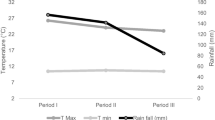Abstract
Two on-farm experiments and one on-station observation were conducted between July 1994 and September 1995 to study the effect of supplementation with fresh fodder of Calliandra calothyrsus on milk production from grade Friesian and Ayrshire cows in the second trimester of their lactations. The cattle were kept under zero-grazing systems on small farms in the coffee-based land use system at altitudes of 1500 to 1800 m on the slopes of Mt Kenya. These cows form a pivotal part of the farming system since they produce both milk for sale and manure for crop production. Milk production is normally in the region of 10 kg/cow per day when the animals are fed on a diet based on Napier grass and crop residues, together with 2–4 kg/day of commercial concentrate. In terms of milk production, 3 kg of fresh calliandra had the same effect on yield as 1 kg of additional dairy meal and, at normal production levels, the effects of the two supplements were strictly additive. Calliandra had a marked positive effect (about a 10% increase) on the butterfat content of the milk, a factor that was highly valued by farmers, even though institutional buyers as yet offer no premium price for milk quality. The average small farm can produce enough calliandra fodder to supplement two dairy cows and some additional small stock from relatively underutilized niches along the farm perimeter and terrace risers, without any adverse effect on current levels of crop production.
Similar content being viewed by others
REFERENCES
Abate, A., Dzowela, B.H. and Kategile, J.A., 1992. Intensive animal feeding practices for optimum feed utilization. In: J.A. Kategile and S. Mubi (eds), Future of Livestock Industries in East and Southern Africa, Proceedings,Workshop, Kadoma Ranch Hotel, Zimbabwe, (International Livestock Centre for Africa (ILCA), Addis Ababa, Ethiopia), 9-19
Franzel, S., Arimi, H., Karanja, J. and Murithi, F., 1996. Calliandra calothyrsus: boosting milk production and income for farm families in Embu. In: Proceedings, First National Agroforestry Conference,Muguga, Kenya
Kaitho, R.J., Tamminga, S. and Bruchem, J., 1993. Rumen degradation and in-vivo digestibility of dried Calliandra calothyrsus leaves. Animal Feed Science and Technology, 43, 19-30
Minae, S. and Nyamae, D., 1988. Agroforestry Research Proposal for the Coffee Based System in the Bimodal Highlands, Central and Eastern Provinces, Kenya, (AFRENA Report No. 16, International Centre for Research in Agroforestry (ICRAF), Nairobi)
Moog, F.A., 1992. Heteropsylla cubana: impact on feeding systems in Southwest Asia and the Pacific. In: A. Speedy and P. Pugliese (eds), Legume Trees and Other Fodder Trees as Protein Sources for Livestock, (FAO Animal Production and Health Paper 102. Food and Agriculture Organization (FAO), Rome), 233-242
Murithi, F.M., O'Neill, M.K., Thijssen, H.J.C., Mugendi, D.N., Mwangi, J.N. and Nyaata, O.Z., 1993. Agroforestry Technologies for Fodder Production and Soil Improvement in Meru District, Kenya, (AFRENA Report No. 76, International Centre for Research in Agroforestry (ICRAF), Nairobi)
NDDP, 1980. Naivasha-Dairy Report, (National Dairy Development Project (NDDP), Nairobi)
Palmer, B. and Schlink, A.C., 1992. The effect of drying on the intake and rate of digestion of the shrub legume Calliandra calothyrsus. Tropical Grasslands, 26, 89-93
Palmer, B., Macqueen, D.J. and Gutteridge, R.C., 1994. Calliandra calothyrsus-multipurpose tree legume for humid conditions. In: R.C. Gutteridge and H.M. Shelton (eds), Forage Tree Legumes in Tropical Agriculture, (CAB International, Wallinford), 65-74
Paterson, R.T., Kariuki, I.W. and Roothaert, R.L., 1996. Calliandra for cows in Kenya. AgroforestryToday, 8(4), 20-21
Paterson, R.T., Dzowela, B.H., Akyeampong, E., Niang, A.I. and Otsyina, R., 1998. A review of ICRAF work with fodder trees in Africa. In: J.N. Daniel and J.M. Roshetko (eds), Nitrogen Fixing Trees for Fodder Production, Proceedings,Workshop in Pune, India,March 1995, (Forest, Farm and Community Tree Research Reports,Winrock International, Morrilton, USA), 24-35
Roothaert, R.L. and Paterson, R.T., 1997. Recent work on the production and utilization of tree fodder in East Africa. Animal Feed Science and Technology, 69, 39-51
van der Veen, W. and Swinkels, R., 1993. Fodder trees: a profitable option for a higher milk production. West Kenya Agroforestry Newsletter, no. 4, July
Author information
Authors and Affiliations
Rights and permissions
About this article
Cite this article
Paterson, R., Kiruiro, E. & Arimi, H. Calliandra calothyrsus as a Supplement for Milk Production in the Kenya Highlands. Tropical Animal Health and Production 31, 115–126 (1999). https://doi.org/10.1023/A:1005119808090
Issue Date:
DOI: https://doi.org/10.1023/A:1005119808090



